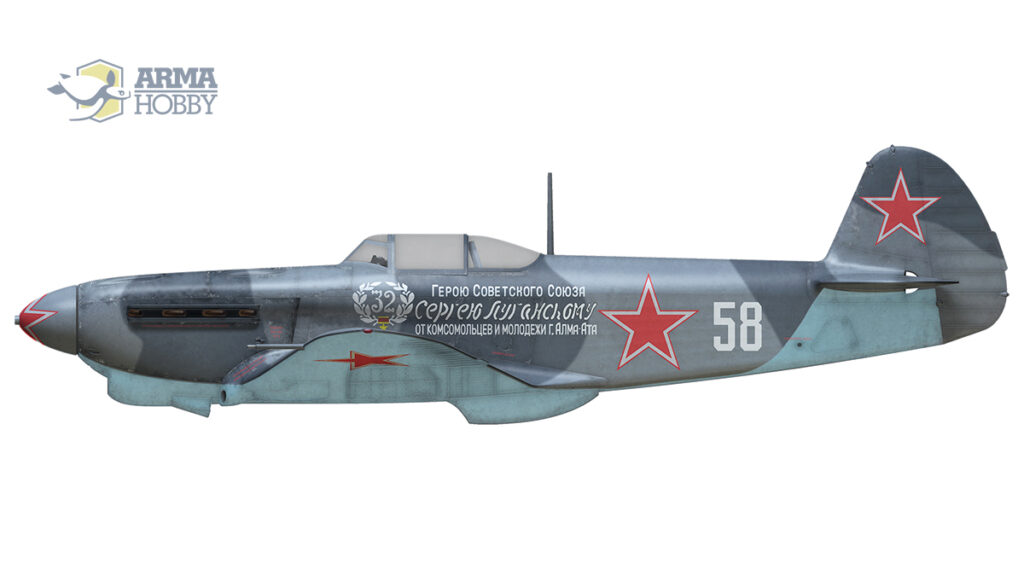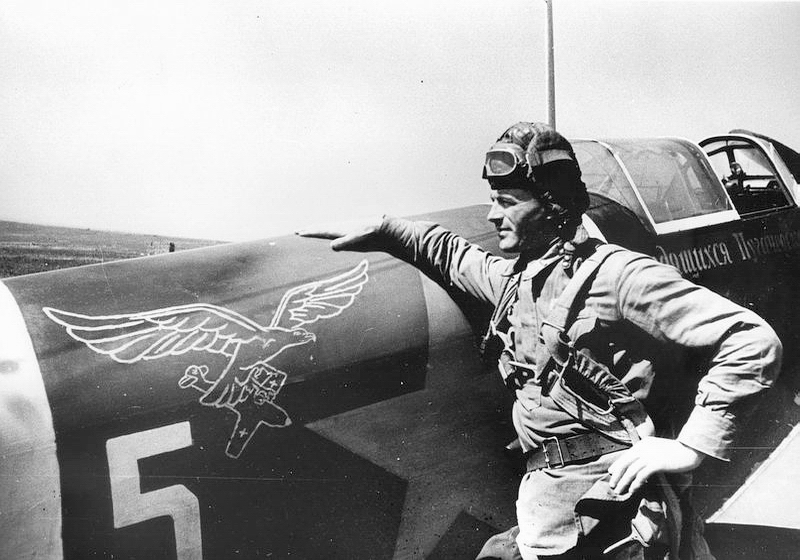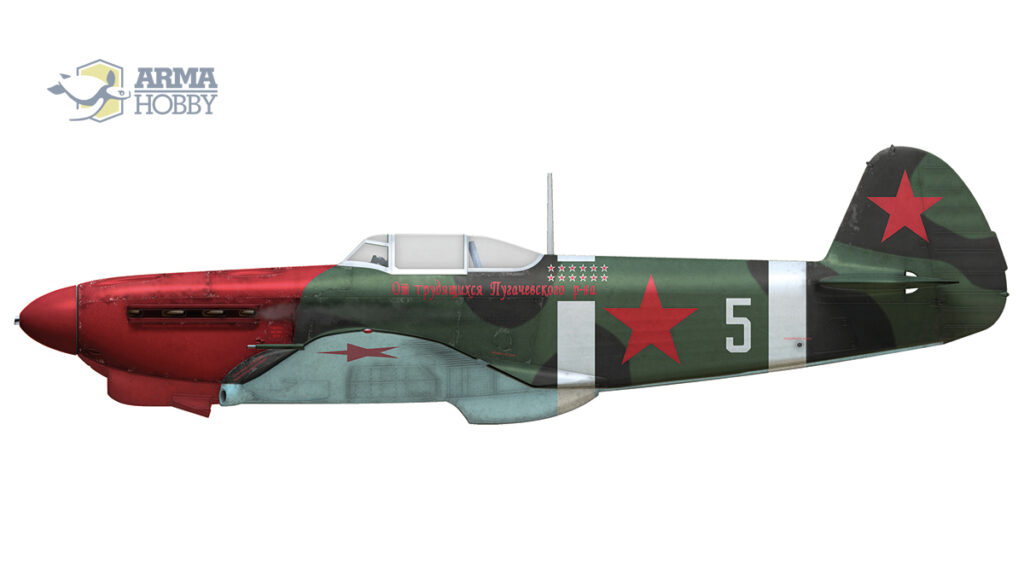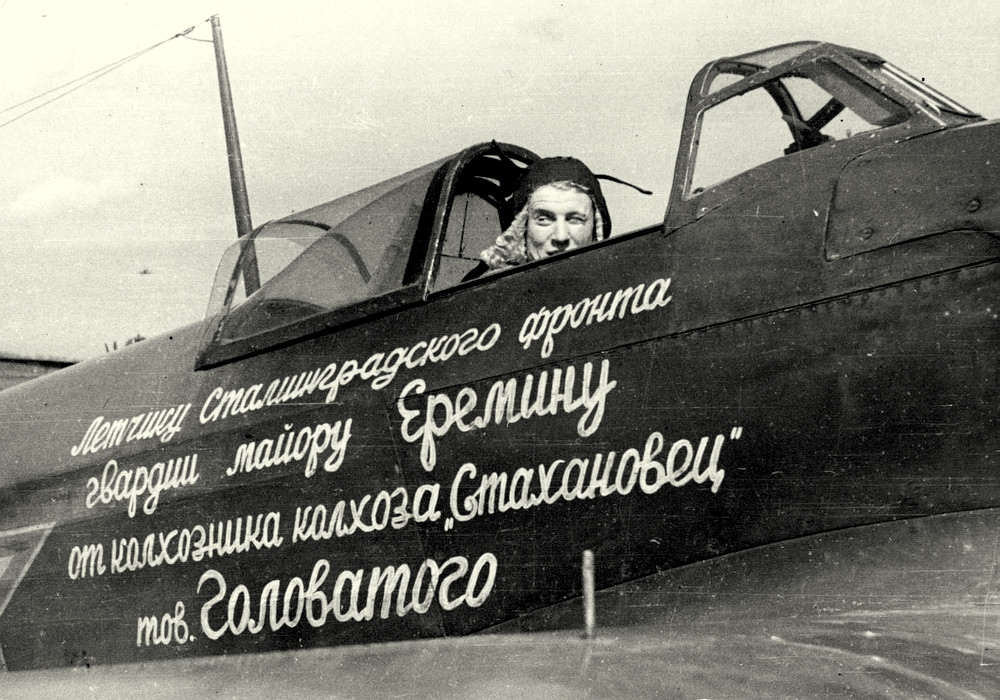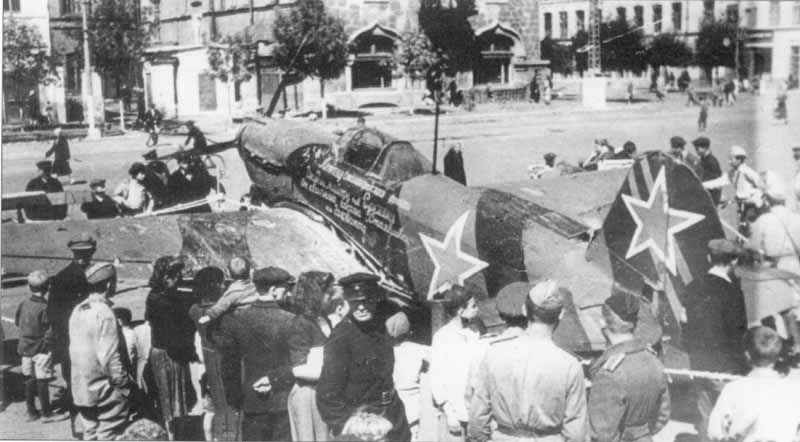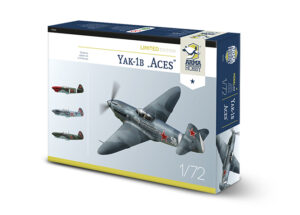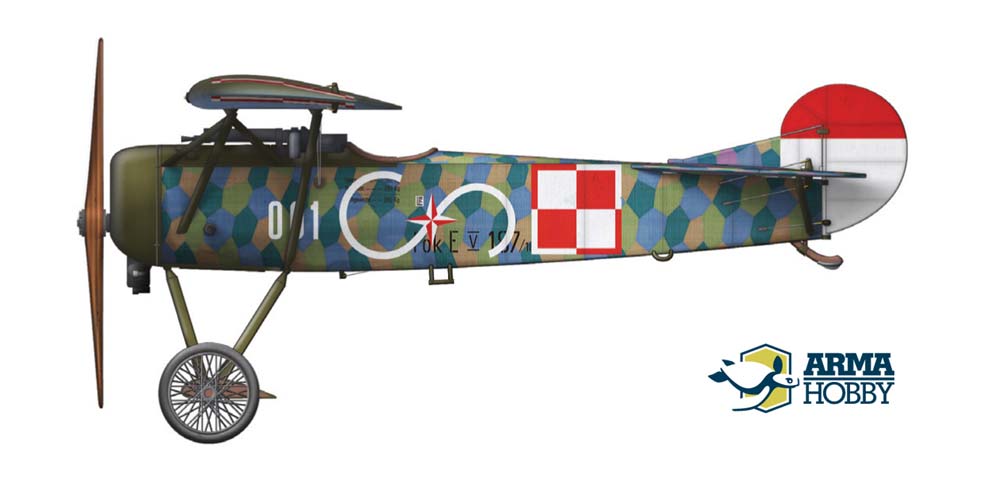During the Second World War, the Eastern Front was the scene of an immense struggle between two hostile powers: Nazi Germany and the Soviet Union. The number of aircraft used, and the sheer violence and length of fighting made possible the emergence of numerous fighter aces on both sides of the conflict. We would like to present the stories of some of these pilots – Soviet aces who flew the Yakovlev Yak-1b.
Yak-1b – Fighter
The Yakovlev Yak-1b aircraft, which was the final version of Yakovlev’s first fighter design, was sent to combat units towards the end of the Battle of Stalingrad (fought between August 1942 and February 1943), and went on to serve as the workhorse fighter of the Soviet Military Air Forces (Voyenno-Vozdushnye Sily, VVS) at the Battle of Kursk (summer 1943). Later, following the introduction of the Yak-9, Yak-3, and the Lavochkin La-7, it was tasked with escorting Ilyushin Il-2M3 Sturmoviks, acquitting itself admirably of this role until the end of the War. Due to the specific nature of operations and the gradual waning of German air strength, Yak-1bs accrued the largest number of victories in the years 1942–43, less in 1944, and comparatively few in 1945. Apart from the VVS, the fighter was also used by French, Polish and Yugoslav units (see link below).
Jak-1b – w lotnictwach sprzymierzonych – malowanie i oznakowanie
Aerial Victories count in VVS
Several dozen Soviet Yak-1b pilots gained ace status for shooting down at least five enemy aircraft. The Soviet system recognised both individual and group victories as “kills”. Thus, in official victory tallies the number of group kills is given in parentheses next to the “solo” number like 5 (3+2). The Western Allies applied a different approach, distinguishing between “confirmed”, “probable” and “damaged”, to which fractions of group kills would be added.
Let us look at the stories of a few select aces from the years 1943–44, whose markings are available in the box of model 70030, Yak-1b “Soviet Aces”.
Yak-1b piloted by Sergey Lugansky, 1944. Artwork by Marcin Górecki.
Major Sergey Danilovich Lugansky
 Sergey Lugansky was born in 1918 in the city of Verny (present-day Almaty, and Alma-Ata until 1993) in Kazakhstan to a Russian family. He enlisted in the Air Force in 1936, and graduated from pilot school in Orenburg two years later. He fought in the Soviet-Finnish Winter War of 1939–40, completing 59 sorties on a Polikarpov I-16 (or Polikarpov I-153). According to some sources, he shot down one enemy aeroplane, and was awarded the Order of the Red Star.
Sergey Lugansky was born in 1918 in the city of Verny (present-day Almaty, and Alma-Ata until 1993) in Kazakhstan to a Russian family. He enlisted in the Air Force in 1936, and graduated from pilot school in Orenburg two years later. He fought in the Soviet-Finnish Winter War of 1939–40, completing 59 sorties on a Polikarpov I-16 (or Polikarpov I-153). According to some sources, he shot down one enemy aeroplane, and was awarded the Order of the Red Star.
Lugansky joined the war against Germany only in October 1941. He initially commanded a section of Lavochkin-Gorbunov-Gudkov LaGG-3 fighters, and was later promoted to deputy commander of a squadron in the 271st Fighter Aviation Regiment (IAP). He achieved three kills on the LaGG-3.
From the summer of 1943, he served as a squadron leader in the 270th IAP, which flew the Yak-1b. He fought in the southern sector of the Kursk salient, and in July of the same year shot down 5 aircraft in five days. On 2 September 1943, having achieved 19 aerial victories (18+1) in 221 combat flights, he was awarded the title of Hero of the Soviet Union (Gold Star no. 1,493) for the first time.
On 27 September, during the fording of the River Dnieper near the village of Mishurin Rog (today in Ukraine: Myszuryn Rih), his squadron was escorting Ilyushin Il-2s. Its task changed, however, when German Junkers Ju-88s and Heinkel He-111s appeared over the crossing. The Junkers were repulsed, and when the Heinkels forced their way through, Lugansky rammed the commanding aircraft. His propeller destroyed the bomber’s elevator, causing it to crash to the ground.
Photos of Major Lugansky’s Yak-1b, 1944 . www.soviet-aces-1936-53.ru
In February 1944, the 270th IAP was renamed as the 152nd Guards Fighter Aviation Regiment (Guards IAP). In July, Sergey Lugansky was promoted to its commander and led the unit until the end of the War. In the same month, he received a personal aeroplane funded by members of the Komsomol and youth from his native Alma-Ata. He was also awarded the title of Hero of the Soviet Union for the second time (Gold Star no. 1,981). From this moment on, he did not score any more officially recognised victories. His aircraft was decorated with the number of 32 “kills” and one Star of the Hero of the Soviet Union (although he had more when he received the aeroplane). Some sources question his official tally, stating that he could have destroyed 43 (37+6) enemy aeroplanes.
Lugansky commanded the 152nd Guards IAP until the end of the War, taking part in combat over Ukraine, southern Poland, and Romania. Following the crossing of the River Odra, he participated in the Battle of Berlin.
Major Lugansky’s aeroplane painted with usual grey camouflage of 1943-45 period. Slogan: “Герою Советского Союза Сергею Луганскому от комсомола и молодёжи г. Алма – Ата” – To the Hero of Soviet Union Sergey Luganski from Komsomol and Youth of city Alma-Ata. Artwork by Zbyszek Malicki.
Captain Pavel Maksimovich Chuvelyov
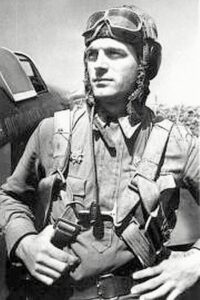 Pavel Chuvelyov was born in 1917 in the settlement of Solenoye Zaymishche on the River Volga, in Astrakhan Oblast. In 1938, he graduated from the flying school in Stalingrad and began service as a pilot of the Soviet Military Air Forces (Voyenno-Vozdushnye Sily, VVS). He fought in the German-Soviet War from the commencement of hostilities in June 1941, flying on a Yak-1 as a section commander in the 20th Fighter Aviation Regiment (IAP). In October, he was transferred to the 427th IAP, advancing to the position of deputy squadron leader and later squadron leader. His career with the regiment and as a Yak-1b pilot came to an end in August 1943, when he was assigned as navigator to the 193rd IAP, which operated the Lavochkin La-5.
Pavel Chuvelyov was born in 1917 in the settlement of Solenoye Zaymishche on the River Volga, in Astrakhan Oblast. In 1938, he graduated from the flying school in Stalingrad and began service as a pilot of the Soviet Military Air Forces (Voyenno-Vozdushnye Sily, VVS). He fought in the German-Soviet War from the commencement of hostilities in June 1941, flying on a Yak-1 as a section commander in the 20th Fighter Aviation Regiment (IAP). In October, he was transferred to the 427th IAP, advancing to the position of deputy squadron leader and later squadron leader. His career with the regiment and as a Yak-1b pilot came to an end in August 1943, when he was assigned as navigator to the 193rd IAP, which operated the Lavochkin La-5.
Prior to this, however, he became one of an elite group of Yak-1 fighter pilots. Namely, a month before his departure, in July 1943, the commander of the 4th Fighter Aviation Corps (IAK), General Ivan D. Podgorny, ordered the formation of a special fighter unit under the code name “Sword”. A total of 16 pilots were selected from the 427th Regiment, creating two units of 8 aeroplanes each (2 sections of 2 pairs). One of these units was commanded by Chuvelyov. In order to develop a sense of camaraderie, the noses of the Yaks allocated to “Sword” were painted red. The group was tasked with winning local air superiority. Its pilots, operating close to the front lines and employing ambush tactics, were summoned by radio to intervene on an ad hoc basis. They also flew reconnaissance missions over German forces in the southern sector of the Kursk salient. On 11 July, Chuvelyov personally reconnoitred vehicles of the II SS Panzer Corps at the approaches to Prokhorovka, which was to be the scene of the largest armoured battled in the entire operation. Let us read what he himself had to say about this mission:
“From the very beginning, our reconnaissance proceeded calmly. There were no outside disturbances, perhaps with the exception of individual shots fired towards our aircraft by enemy anti-aircraft guns. We flew one half of the route like this, however later the situation grew complicated. The weather began to force us groundwards, with the clouds coming down to 75 metres. The anti-aircraft fire grew in intensity, while when we were drawing near to the village of Belenichino (close to Prokhorovka), I saw a large grouping of enemy tanks – I would estimate that there were as many as 800 vehicles. At that very moment, our aeroplanes were enveloped in a hurricane of fire from the ground; this destabilised our formation and each of us proceeded to act independently (such an eventuality had been anticipated before the flight).
(…)
I am glad that the pilots of the “Sword” special group, a unit of which I at the time commanded, took part in this famous military operation”.
Chuvelyov’s aeroplane was seriously damaged by the shellfire. One of the projectiles tore a large hole, 50 cm in diameter, right next to the fuel tank, and the aircraft became very difficult to control. The pilot made it back to base, however, and reported his findings, whereupon a detachment of Ilyushin Il-2M3 Sturmoviks was immediately sent to the location.
During the Second World War, Pavel Maksimovich Chuvelyov scored 7 individual and 5 group aerial victories.
Photos of Chuvelyov’s aeroplane, www.soviet-aces-1936-53.ru
Chuvelyov’s aeroplane in factory camouflage from 1941-43 period. Red nose is an insignia of “Sword” group, white stripes may be commander of sub-unit insignia. Slogan: “От трудящихся Пугачевского р-на” – “From workers of Pugachov Region”. Artowrok by Zbyszek Malicki.
Major Aleksey Mikhailovich Reshetov
 Aleksey Reshetov was born in 1921 in the village of Mykanino in Moscow Oblast. In 1940, he graduated from Borysogleb Aviation School, and, after passing through a number of different units, ended up in the 273rd Fighter Aviation Regiment (IAP). The unit was equipped with Yakovlev Yak-7 and Yak-9 fighters, and fought in the defence of Stalingrad. In August 1942, he was promoted to the command of a section. On 22 November (the day when the encirclement of the German 6th Army was completed at Kalach west of Stalingrad), the 273rd IAP was renamed as the 31st Guards Fighter Aviation Regiment (Guards IAP). Once the Battle of Stalingrad drew to a close in February 1943, Reshetov was given command of a squadron. In May 1943, he was awarded the title of Hero of the Soviet Union (Gold Star no. 732) for 100 aerial combats and 19 victories (18+1). In 1944, he received a personally named Yak-1b, which was funded by kolkhoz members from the village council of Shotovka in Ivano-Frankivsk (Stanislavov) Oblast, Ukraine. He flew this aeroplane until April 1945, when he transferred to a Yak-9U.
Aleksey Reshetov was born in 1921 in the village of Mykanino in Moscow Oblast. In 1940, he graduated from Borysogleb Aviation School, and, after passing through a number of different units, ended up in the 273rd Fighter Aviation Regiment (IAP). The unit was equipped with Yakovlev Yak-7 and Yak-9 fighters, and fought in the defence of Stalingrad. In August 1942, he was promoted to the command of a section. On 22 November (the day when the encirclement of the German 6th Army was completed at Kalach west of Stalingrad), the 273rd IAP was renamed as the 31st Guards Fighter Aviation Regiment (Guards IAP). Once the Battle of Stalingrad drew to a close in February 1943, Reshetov was given command of a squadron. In May 1943, he was awarded the title of Hero of the Soviet Union (Gold Star no. 732) for 100 aerial combats and 19 victories (18+1). In 1944, he received a personally named Yak-1b, which was funded by kolkhoz members from the village council of Shotovka in Ivano-Frankivsk (Stanislavov) Oblast, Ukraine. He flew this aeroplane until April 1945, when he transferred to a Yak-9U.
In total, Major Aleksey Mikhailovich Reshetov achieved 32 kills (22 solo and 10 group).
Reshetov’s aeroplane photo, www.soviet-aces-1936-53.ru
Reshetov’s Yak-1b in usual grey camouflage of 1943-45 period. Slogan: “Колхозники Шотовского с/совета Ивановского района Запорожской области – Герою Советского Союза Гвардии майору Рететову” what is “Kholkhoz memebers from Shotovo village council, Ivanovsk region of Zoporozhye Oblast’ – to Hero of soviet Union Guards Major Reshetov”. Two red stripes on tail are 31 GuIAP insignia. Artwork by Zbyszek Malicki.
Major Boris Nikolayevich Yeriomin
 Boris Yeriomin was born in 1913 in Saratov. His route to military aviation was somewhat more difficult. He commenced his military service as an aviation mechanic at the beginning of the 1930s, while in 1938 he took part in the Battle of Lake Khasan against the Japanese; only then did he receive pilot training.
Boris Yeriomin was born in 1913 in Saratov. His route to military aviation was somewhat more difficult. He commenced his military service as an aviation mechanic at the beginning of the 1930s, while in 1938 he took part in the Battle of Lake Khasan against the Japanese; only then did he receive pilot training.
Yeriomin is probably the most important pilot in the history of the Yak-1b. His personally named aircraft gained fame already when it was being officially handed over to him by kolkhoz worker Golovaty in Saratov in December 1942. When he completed his military service in May 1944, the fighter was transferred to Saratov Museum, where it can be viewed even today. The story of this aeroplane has been described in detail in the article linked below.
.
Zdjęcie prawej burty Jak-1b Jeriomina, www.soviet-aces-1936-53.ru
Yeriomin ‘s Yak-1b on the exhibition in Saratov, 1944. Photo Antologia Jak.
Boris Yeriomin was an extraordinary person, due – among others – to his inspiring modesty (he famously refused to accept the title of Hero of the Soviet Union in 1942, saying “We have all fought equally hard”, while he himself taught or commanded at least a dozen or so Heroes). His tally amounted to 23 aerial victories (8+15). Major Boris Yeriomin received the title of Hero of the Soviet Union from President Boris Yeltsin in 1990.
Boris Yeriomin’s aeroplane after white camouflage washed out in Spring 1943. Yaks manufactured in Winter 1942-43 were usually painted with green uppersurfaces covered with whitewash. After winter camo removed; black colour stripes were painted in units, so they differ from factory green/black pattern. The presentation inscription was on the port side of the fuselage read „Летчику Сталинградского фронта гвардии майору тов. Еремину от колхозника колхоза “Стахановец” тов. Головатова” (The Stalingrad Front pilot Guards Maj. comrade Yeryemin from a member of Kolkhoz “Stakhanovets” comrade Golovatov). On the tail red stripes of 31 GuIAP were painted. Artwork by Zbyszek Malicki.
- English Translation by Maciej Zakrzewski
See also:
- Buy Yak-1b “Soviet Aces” kit in Arma Hobby webstore.
Modeller happy enough to work in his hobby. Seems to be a quiet Aspie but you were warned. Enjoys talking about modelling, conspiracy theories, Grand Duchy of Lithuania and internet marketing. Co-founder of Arma Hobby. Builds and paints figurines, aeroplane and armour kits, mostly Polish subject and naval aviation.
This post is also available in:
 polski
polski






